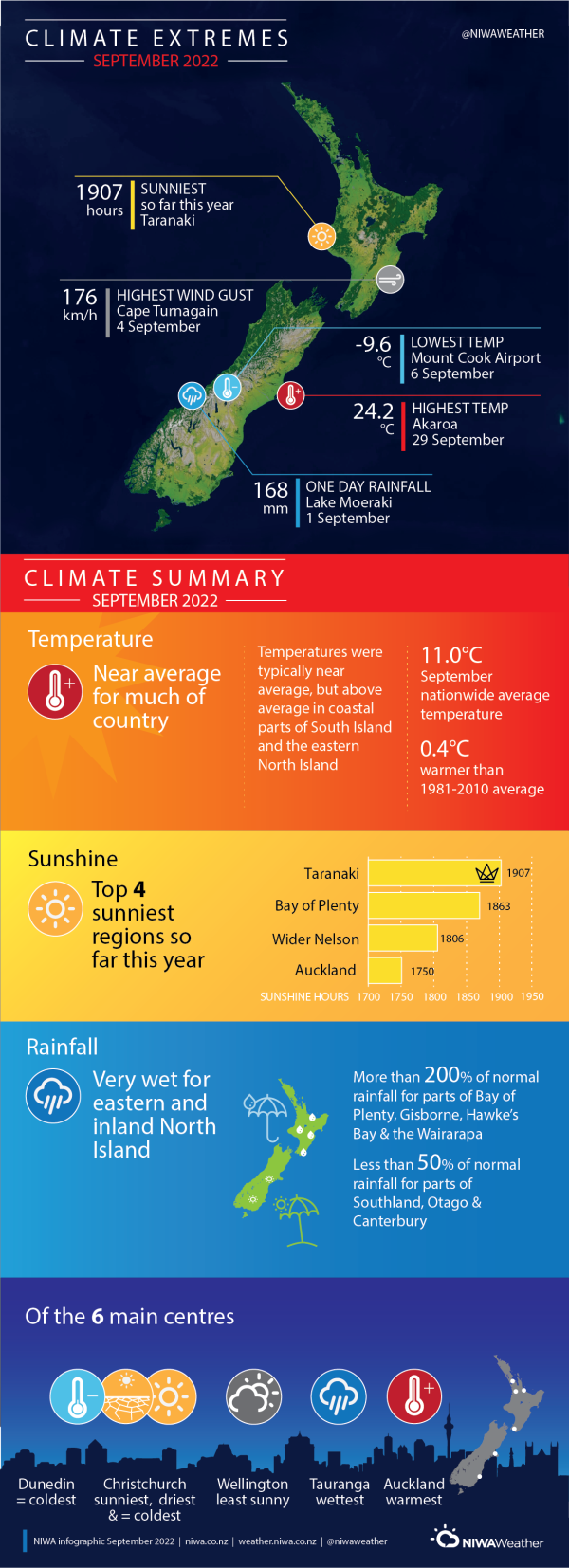Wet for the eastern North Island, dry for the South Island
|
Rainfall |
Rainfall was above normal (120-149% of normal) or well above normal rainfall (>149% of normal) in parts of northern Northland and Auckland, Waikato, Bay of Plenty, Gisborne, Hawke’s Bay, Wairarapa and southeastern Marlborough. Rainfall was below normal (50-79% of normal) or well below normal (<50% of normal) for most of the South Island, parts of Kāpiti Coast, and central parts of Northland. Near normal rainfall (80-119% of normal) was typically observed elsewhere. |
|
Temperature |
Temperatures were near average (within ±0.50°C of average) for most of the country. Areas of above average temperatures (0.51°C to 1.20°C above average) were observed in coastal Southland, West Coast, isolated eastern parts of Canterbury, Nelson, Tasman, Manawatū, Hawke’s Bay, inland Gisborne, eastern Bay of Plenty, central Waikato, and northern Northland. |
|
Soil Moisture |
At the end of the month, and for the time of year, soil moisture levels were higher than normal in coastal parts of Gisborne and Hawke’s Bay, much of Marlborough, and Kaikōura. Soil moisture levels were also higher than normal for a small portion of Central Otago about Alexandra, Clyde, and Cromwell, which was a relic of the exceptionally high rainfall observed in these parts during July and August. Soil moisture levels were typically near normal for most remaining parts of New Zealand. The exception was eastern parts of Otago, where soil moisture levels were lower than normal. |
Overview
September 2022 was characterised by higher than normal mean sea level pressure (MSLP) over Aotearoa New Zealand, but especially near the South Island. This produced more northeasterly airflow than normal in the North Island, and more easterly airflow than normal in the South Island. The prominence of high pressure systems over and near the South Island deflected moisture-bearing low pressure systems off towards the north of the country, with North Island areas exposed to the east bearing the brunt of the precipitation as these low pressure systems passed by. The relative lack of westerly winds during the month was notable because these are a hallmark of early spring weather patterns in New Zealand.
The observed MSLP patterns for the month were associated with a continuation of a moderate La Niña event, and a positive Southern Annular Mode (SAM). The SAM is a proxy for the location of a belt of westerly winds that encircle the South Ocean and occasionally protrude into the mid-latitudes. Usually, a positive SAM can indicate calmer and drier conditions for New Zealand, and this was certainly the case for most of the South Island.
Rainfall was above normal (120-149% of normal) or well above normal rainfall (>149% of normal) in parts of northern Northland and Auckland, Waikato, Bay of Plenty, Gisborne, Hawke’s Bay, Wairarapa and southeastern Marlborough. It was an exceptionally wet month about western Bay of Plenty, Gisborne, Hawke’s Bay and coastal Wairarapa where more than 200% of normal September rainfall was recorded. Rainfall was below normal (50-79% of normal) or well below normal (<50% of normal) for most of the South Island, Stewart Island, parts of Kāpiti Coast, and central parts of Northland. Near normal rainfall (80-119% of normal) was commonly observed in Tasman, Nelson, inland Marlborough, western parts of the North Island and Auckland.
Temperatures were near average (±0.50°C of average) for most of the country during the month. The exception was areas of coastal Southland, West Coast, isolated eastern parts of Canterbury, Nelson, Tasman, Manawatū, Hawke’s Bay, inland Gisborne, eastern Bay of Plenty, central Waikato, and northern Northland, where temperatures were above average (0.51°C to 1.20°C above average). Overall, the nationwide average temperature in September 2022 was 11.0°C. This was 0.4°C above the 1981-2010 September average, making it New Zealand’s 19th-warmest September since NIWA’s seven station temperature series began in 1909.
Further Highlights:
- The highest September temperature was 24.2°C, observed at Akaroa on 29 September.
- The lowest September temperature was -9.6°C, observed at Mount Cook Airport on 6 September.
- The highest 1-day rainfall was 168 mm, recorded at Lake Moeraki on 1 September.
- The highest wind gust was 176 km/h, observed at Cape Turnagain on 4 September.
- Of the six main centres in September 2022, Auckland was the warmest, Christchurch was the sunniest and driest, Tauranga was the wettest, Wellington was the least sunny, and Christchurch and Dunedin were the equal-coldest.
- Of the available, regularly reporting sunshine observation sites, the sunniest four regions in 2022 so far are Taranaki (1907 hours), Bay of Plenty (1863 hours), Wider Nelson (1806 hours), and Auckland (1750 hours).
Download
- Climate Summary September 2022 [PDF 328 KB]
- Climate Statistics September 2022 [PDF 156 KB]


